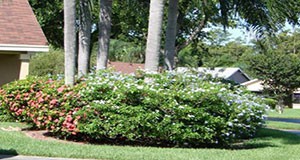
Early efforts to promote Florida-Friendly landscapes emphasized the use of drought-tolerant plants, which created a negative association with a visually unappealing landscape. This has hampered the promotion of FFL yards and the adoption by homeowner associations. But recently many homeowners are rethinking their landscape maintenance and plant choices and HOAs are considering promoting environmentally friendly landscapes but express uncertainty about recommending FFL because of the need to maintain visual quality. We conducted a study to address both groups’ concerns and help develop FFL-oriented landscape codes that meet both groups’ needs. This 7-page fact sheet was written by Gail Hansen, Laura Warner, Paul Monaghan, Emily Ott, Tim Fogarty, Claire Lewis, and Esen Momol, and published by the UF Department of Environmental Horticulture, April 2015.
http://edis.ifas.ufl.edu/ep519
Tag: Environmental Horticulture Department
Olives for Your Florida Landscape
 Olives have great potential as a landscape ornamental and may also provide opportunities for home fruit production. However, as a relatively new commercial crop to Florida, the cultural requirements of these trees are not completely known and research is ongoing to understand how to manage them for plant health and fruit yield as well as to make recommendations on varietal selections best suited to the southeastern region of the United States. This 5-page fact sheet includes culture and management information, selected references, and a table listing a selection of olive cultivars currently available in the U.S. Written by Mack Thetford, Jennifer L. Gillett-Kaufman, Michael J. Mulvaney, and published by the UF Department of Environmental Horticulture, February 2015.
Olives have great potential as a landscape ornamental and may also provide opportunities for home fruit production. However, as a relatively new commercial crop to Florida, the cultural requirements of these trees are not completely known and research is ongoing to understand how to manage them for plant health and fruit yield as well as to make recommendations on varietal selections best suited to the southeastern region of the United States. This 5-page fact sheet includes culture and management information, selected references, and a table listing a selection of olive cultivars currently available in the U.S. Written by Mack Thetford, Jennifer L. Gillett-Kaufman, Michael J. Mulvaney, and published by the UF Department of Environmental Horticulture, February 2015.
http://edis.ifas.ufl.edu/ep515
Not All Landscape Palm Fertilizers Are Created Equal
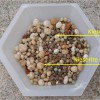 Palms are widely planted in Florida landscapes. Their bold leaf textures create a tropical or Mediterranean look that is highly desired by residents and tourists alike. But palms have very high nutritional requirements, and deficiencies of any element can result in conspicuous and unattractive symptoms on their large leaves. UF/IFAS research shows that the most effective fertilizer has 100% of the N, K, Mg, and B sources in slow-release or controlled-release form and that all of the Mn, Fe, Zn, and Cu sources should be water soluble. This 4-page fact sheet explains the reasons for this recommendation and how to ensure that you have a formulation that will be effective. Written by Timothy K. Broschat, and published by the UF Department of Environmental Horticulture, March 2015. (Photo Credit: T.K. Broschat)
Palms are widely planted in Florida landscapes. Their bold leaf textures create a tropical or Mediterranean look that is highly desired by residents and tourists alike. But palms have very high nutritional requirements, and deficiencies of any element can result in conspicuous and unattractive symptoms on their large leaves. UF/IFAS research shows that the most effective fertilizer has 100% of the N, K, Mg, and B sources in slow-release or controlled-release form and that all of the Mn, Fe, Zn, and Cu sources should be water soluble. This 4-page fact sheet explains the reasons for this recommendation and how to ensure that you have a formulation that will be effective. Written by Timothy K. Broschat, and published by the UF Department of Environmental Horticulture, March 2015. (Photo Credit: T.K. Broschat)
http://edis.ifas.ufl.edu/ep516
Biology and Management of Oxalis (Oxalis stricta) in Ornamental Crop Production
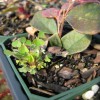 Oxalis grows throughout the year in Florida. It can be found growing in sidewalk cracks, alongside trails, in lawns, flower beds, cultivated fields, and in container nursery stock. In greenhouse studies, oxalis populations have been shown to negatively impact the growth rates of ornamental crops. This 6-page fact sheet was written by Matt Lollar and Chris Marble, and published by the UF Department of Environmental Horticulture, February 2015. (Photo: Chris Marble)
Oxalis grows throughout the year in Florida. It can be found growing in sidewalk cracks, alongside trails, in lawns, flower beds, cultivated fields, and in container nursery stock. In greenhouse studies, oxalis populations have been shown to negatively impact the growth rates of ornamental crops. This 6-page fact sheet was written by Matt Lollar and Chris Marble, and published by the UF Department of Environmental Horticulture, February 2015. (Photo: Chris Marble)
http://edis.ifas.ufl.edu/ep514
Bismarckia nobilis: Bismarck Palm
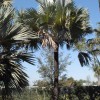 The Bismarck palm is a native of Madagascar that grows to a height of 30 to 60 feet with a spread of 12 to 16 feet. The massive 4-foot-wide costapalmate leaves are typically silver-green in color, but a light olive-green-leaved variety also exists. The persistent leaf bases are split, creating an attractive pattern on the 15–18-inch-diameter trunks. The dark brown male and female inflorescences are produced on separate trees, with females developing olive-brown fruit about 1.5 inches in diameter. The bold texture and color and eventual great height of this species make a strong statement in any setting, but can be overpowering in small residential landscapes. This 3-page fact sheet was written by Timothy Broschat, and published by the UF Department of Environmental Horticulture, February 2015. (Photo credit: T. K. Broschat)
The Bismarck palm is a native of Madagascar that grows to a height of 30 to 60 feet with a spread of 12 to 16 feet. The massive 4-foot-wide costapalmate leaves are typically silver-green in color, but a light olive-green-leaved variety also exists. The persistent leaf bases are split, creating an attractive pattern on the 15–18-inch-diameter trunks. The dark brown male and female inflorescences are produced on separate trees, with females developing olive-brown fruit about 1.5 inches in diameter. The bold texture and color and eventual great height of this species make a strong statement in any setting, but can be overpowering in small residential landscapes. This 3-page fact sheet was written by Timothy Broschat, and published by the UF Department of Environmental Horticulture, February 2015. (Photo credit: T. K. Broschat)
http://edis.ifas.ufl.edu/st101
Ten Strategies for Working With Your Home Owner Association to Convert to a Florida-Friendly Yard
 Many homeowners are beginning to rethink their landscapes for several reasons, including mandated water and fertilizer restrictions, increasing maintenance costs, and concern for the environment. But over sixty million people now live in neighborhoods governed by Homeowner Associations, whose regulations can make it difficult to implement some changes by mandating types of plants, percentages of turf and plant material, location of plant materials, and restricting specialty gardens to back yards. More environmentally sound landscapes are possible with careful planning and design and by using an educated and knowledgeable approach to working with the HOA board to gain approval for a new landscape. This 9-page fact sheet offers several strategies for working within HOA regulations to gain approval for a Florida-Friendly landscape. Written by Gail Hansen and Claire Lewis, and published by the UF Department of Environmental Horticulture, February 2015. (Photo credit: Florida-Friendly Landscaping™ Program)
Many homeowners are beginning to rethink their landscapes for several reasons, including mandated water and fertilizer restrictions, increasing maintenance costs, and concern for the environment. But over sixty million people now live in neighborhoods governed by Homeowner Associations, whose regulations can make it difficult to implement some changes by mandating types of plants, percentages of turf and plant material, location of plant materials, and restricting specialty gardens to back yards. More environmentally sound landscapes are possible with careful planning and design and by using an educated and knowledgeable approach to working with the HOA board to gain approval for a new landscape. This 9-page fact sheet offers several strategies for working within HOA regulations to gain approval for a Florida-Friendly landscape. Written by Gail Hansen and Claire Lewis, and published by the UF Department of Environmental Horticulture, February 2015. (Photo credit: Florida-Friendly Landscaping™ Program)
http://edis.ifas.ufl.edu/ep513
Biology and Management of Eclipta (Eclipta prostrata) in Ornamental Crop Production
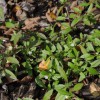 Eclipta grows aggressively in containers and can outcompete nursery crops for water, nutrients, and light. Plants flower in as little as five weeks after germination and produce thousands of seeds over the course of a growing season, and stem fragments left on the soil or media surface following hand-weeding or cultivation can root and reproduce vegetatively. This 4-page fact sheet describes the plant, its biology, and recommendations for physical, cultural, and chemical control. Written by Chris Marble, Shawn Steed, and Nathan S. Boyd, and published by the UF Department of Environmental Horticulture, January 2015. (Photo: Annette Chandler, UF/IFAS)
Eclipta grows aggressively in containers and can outcompete nursery crops for water, nutrients, and light. Plants flower in as little as five weeks after germination and produce thousands of seeds over the course of a growing season, and stem fragments left on the soil or media surface following hand-weeding or cultivation can root and reproduce vegetatively. This 4-page fact sheet describes the plant, its biology, and recommendations for physical, cultural, and chemical control. Written by Chris Marble, Shawn Steed, and Nathan S. Boyd, and published by the UF Department of Environmental Horticulture, January 2015. (Photo: Annette Chandler, UF/IFAS)
http://edis.ifas.ufl.edu/ep512
Biology and Management of Hairy Bittercress (Cardamine hirsute) in Ornamental Crop Production
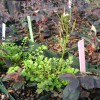 Bittercress commonly grows in the potting media of container-grown ornamentals and often through drainage holes in nursery containers. It also can be a problem in propagation houses, greenhouses, and in the field. This 6-page fact sheet provides species description, plant biology, and management recommendations. Written by Chris Marble, Shawn Steed, and Nathan S. Boyd, and published by the UF Department of Environmental Horticulture, December 2014.
Bittercress commonly grows in the potting media of container-grown ornamentals and often through drainage holes in nursery containers. It also can be a problem in propagation houses, greenhouses, and in the field. This 6-page fact sheet provides species description, plant biology, and management recommendations. Written by Chris Marble, Shawn Steed, and Nathan S. Boyd, and published by the UF Department of Environmental Horticulture, December 2014.
http://edis.ifas.ufl.edu/ep511
Postemergent Herbicides for Use In Ornamentals
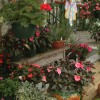 Postemergent herbicides are applied directly to weeds. This 5-page fact sheet is largely comprised of two tables: Table one lists postemergent herbicides that can be safely used over the top of some ornamentals when used according to label directions; table 2 lists postemergent herbicides that are registered for use around ornamental plants when applied as a directed spray. Written by Jeffrey G. Norcini and Chris Marble, and published by the UF Department of Environmental Horticulture, November 2014. (UF/IFAS photo: Thomas Wright)
Postemergent herbicides are applied directly to weeds. This 5-page fact sheet is largely comprised of two tables: Table one lists postemergent herbicides that can be safely used over the top of some ornamentals when used according to label directions; table 2 lists postemergent herbicides that are registered for use around ornamental plants when applied as a directed spray. Written by Jeffrey G. Norcini and Chris Marble, and published by the UF Department of Environmental Horticulture, November 2014. (UF/IFAS photo: Thomas Wright)
http://edis.ifas.ufl.edu/wg059
Parana Pine, Araucaria angustifolia: An Ancient-Looking Conifer for Modern Landscapes
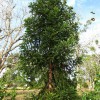 Paraná pine is a primitive-looking conifer valued for its unusual horizontal branching, interesting triangular-shaped needles, and neat, symmetrical form. The primitive appearance of this evergreen tree results from its resemblance to and relationship with an ancient group of Araucaria-related conifers that dominated forests more than 145 million years ago. This tree once covered vast areas in southern Brazil, Argentina and Paraguay. Native Americans harvest the seeds for food. It was an important timber tree for European settlers, and it was logged extensively through the 20th century. Now one of the rarest trees in Brazil, Paraná pine is considered critically endangered due to habitat loss and exploitation. This evergreen conifer grows too large for most residential situations, but is best used as an accent or conversation piece in large-scale landscapes. This 3-page fact sheet was written by Gary W. Knox, and published by the UF Department of Environmental Horticulture, November 2014.
Paraná pine is a primitive-looking conifer valued for its unusual horizontal branching, interesting triangular-shaped needles, and neat, symmetrical form. The primitive appearance of this evergreen tree results from its resemblance to and relationship with an ancient group of Araucaria-related conifers that dominated forests more than 145 million years ago. This tree once covered vast areas in southern Brazil, Argentina and Paraguay. Native Americans harvest the seeds for food. It was an important timber tree for European settlers, and it was logged extensively through the 20th century. Now one of the rarest trees in Brazil, Paraná pine is considered critically endangered due to habitat loss and exploitation. This evergreen conifer grows too large for most residential situations, but is best used as an accent or conversation piece in large-scale landscapes. This 3-page fact sheet was written by Gary W. Knox, and published by the UF Department of Environmental Horticulture, November 2014.
http://edis.ifas.ufl.edu/ep509
Is My Tree Safe? Recognizing Conditions that Increase the Likelihood of Tree Failure
 Urban trees provide shade and beauty and the urban forest as a whole provides a wealth of benefits to neighborhoods and residents. But stresses from the urban environment may lead to problems that pose an unacceptable safety risk to people and property. It is a landowner’s responsibility to ensure that the trees on their property are safe. A key step in reducing the potential for tree-related injury or property damage is learning to identify common tree defects associated with increased risk of failure. This 5-page fact sheet highlights seven easily reconizable tree defects that homeowners and non-professionals in public agencies. may encounter in Florida. Written by Drew C. McLean, Andrew K. Koeser, Robert J. Northrop, and Gitta Hasing, and published by the UF Department of Environmental Horticulture, October 2014. (Photo by Gitta Hasing)
Urban trees provide shade and beauty and the urban forest as a whole provides a wealth of benefits to neighborhoods and residents. But stresses from the urban environment may lead to problems that pose an unacceptable safety risk to people and property. It is a landowner’s responsibility to ensure that the trees on their property are safe. A key step in reducing the potential for tree-related injury or property damage is learning to identify common tree defects associated with increased risk of failure. This 5-page fact sheet highlights seven easily reconizable tree defects that homeowners and non-professionals in public agencies. may encounter in Florida. Written by Drew C. McLean, Andrew K. Koeser, Robert J. Northrop, and Gitta Hasing, and published by the UF Department of Environmental Horticulture, October 2014. (Photo by Gitta Hasing)
http://edis.ifas.ufl.edu/ep507
Homeowner Best Management Practices for the Home Lawn
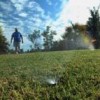 A healthy lawn is an important component of an urban landscape. Loss of turf health and misuse of fertilizers can result increased nonpoint source pollution, so homeowners should use Best Management Practices when maintaining their lawns. Best Management Practices follow Florida-Friendly Landscaping™ principles, developed for maintenance of a healthy landscape that does not contribute to nonpoint source pollution. This 6-page fact sheet provides easy-to-follow tips on Florida-friendly lawn maintenance. Written by Laurie E. Trenholm, and published by the UF Department of Environmental Horticulture, October 2014.
A healthy lawn is an important component of an urban landscape. Loss of turf health and misuse of fertilizers can result increased nonpoint source pollution, so homeowners should use Best Management Practices when maintaining their lawns. Best Management Practices follow Florida-Friendly Landscaping™ principles, developed for maintenance of a healthy landscape that does not contribute to nonpoint source pollution. This 6-page fact sheet provides easy-to-follow tips on Florida-friendly lawn maintenance. Written by Laurie E. Trenholm, and published by the UF Department of Environmental Horticulture, October 2014.
http://edis.ifas.ufl.edu/ep236
Advanced Tree Risk Assessment: Resistance Recording Drills
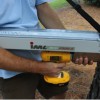 Resistance recording drills are specialized pieces of decay detection equipment that may be used as part of an advanced risk assessment. While not required for tree risk assessment work, resistance recording drills have been shown to be effective in helping arborists detect and document internal tree decay in trees. This 5-page fact sheet was written by Drew McLean, Andrew Koeser, and Gitta Hasing, and published by the UF Department of Environmental Horticulture, October 2014.
Resistance recording drills are specialized pieces of decay detection equipment that may be used as part of an advanced risk assessment. While not required for tree risk assessment work, resistance recording drills have been shown to be effective in helping arborists detect and document internal tree decay in trees. This 5-page fact sheet was written by Drew McLean, Andrew Koeser, and Gitta Hasing, and published by the UF Department of Environmental Horticulture, October 2014.
http://edis.ifas.ufl.edu/ep504
Gardening with Annuals in Florida
 Annuals offer an almost infinite variety of flower color and plant form. They brighten landscape beds and add a splash of color to a porch, deck, or patio when placed in containers. Some also make good cut flowers. This 6-page fact sheet was written by Sydney Park Brown, and published by the UF Department of Environmental Horticulture, August 2014.
Annuals offer an almost infinite variety of flower color and plant form. They brighten landscape beds and add a splash of color to a porch, deck, or patio when placed in containers. Some also make good cut flowers. This 6-page fact sheet was written by Sydney Park Brown, and published by the UF Department of Environmental Horticulture, August 2014.
http://edis.ifas.ufl.edu/mg319
Phoenix roebelenii: Pygmy Date Palm
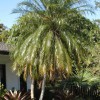 The pygmy date palm is one of the most popular small landscape palms in Florida. It is single-stemmed, but is often grown in clumps of 2–4 closely spaced individuals which, when older, give the impression of a multi-stemmed palm. This 4-page fact sheet was written by Timothy K. Broschat, and published by the UF Department of Environmental Horticulture, August 2014.
The pygmy date palm is one of the most popular small landscape palms in Florida. It is single-stemmed, but is often grown in clumps of 2–4 closely spaced individuals which, when older, give the impression of a multi-stemmed palm. This 4-page fact sheet was written by Timothy K. Broschat, and published by the UF Department of Environmental Horticulture, August 2014.
http://edis.ifas.ufl.edu/st441
Purple Sunset Pomegranate (Punica granatum ‘PIIPG-1’)
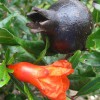 Purple Sunset is a new ornamental cultivar of pomegranate, Punica granatum. Purple Sunset pomegranate is distinguished from fruiting pomegranate by a bushy, compact habit and numerous flowers followed by small, ornamental, purple-black fruit. This 2-page fact sheet was written by Gary W. Knox, and published by the UF Department of Environmental Horticulture, June 2014.
Purple Sunset is a new ornamental cultivar of pomegranate, Punica granatum. Purple Sunset pomegranate is distinguished from fruiting pomegranate by a bushy, compact habit and numerous flowers followed by small, ornamental, purple-black fruit. This 2-page fact sheet was written by Gary W. Knox, and published by the UF Department of Environmental Horticulture, June 2014.
http://edis.ifas.ufl.edu/ep501
Mexican Sycamore (Platanus mexicana)
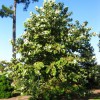 Mexican sycamore (Platanus Mexicana) is a fast growing, drought tolerant tree boasting smooth white and tan bark and large, maple-like leaves with velvety, silver undersides. Native to northeastern and central Mexico, this tree’s cold hardiness is not well defined. However, Mexican sycamore grows well as far north as USDA Cold Hardiness Zone 8b in Texas and Florida. This 2-page fact sheet was written by Gary W. Knox, and published by the UF Department of Environmental Horticulture, June 2014.
Mexican sycamore (Platanus Mexicana) is a fast growing, drought tolerant tree boasting smooth white and tan bark and large, maple-like leaves with velvety, silver undersides. Native to northeastern and central Mexico, this tree’s cold hardiness is not well defined. However, Mexican sycamore grows well as far north as USDA Cold Hardiness Zone 8b in Texas and Florida. This 2-page fact sheet was written by Gary W. Knox, and published by the UF Department of Environmental Horticulture, June 2014.
http://edis.ifas.ufl.edu/ep502
Demonstration Gardens in the University of Florida Cooperative Extension Service
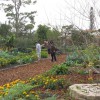 UF/IFAS Extension supports a network of demonstration gardens throughout the state. These gardens showcase plants and practices appropriate for their locations and are open to the community free of charge. Learning opportunities abound for home gardeners and landscape professionals on design, planting, and maintenance procedures. The gardens typically have interpretative materials available, including signs, brochures, and self-guided tours. Many are sites for gardening festivals, workshops, and plant sales. This 27-page directory was written by Sydney Park Brown, Kim Taylor, and Emily Eubanks, and published by the UF Department of Environmental Horticulture, March 2014.
UF/IFAS Extension supports a network of demonstration gardens throughout the state. These gardens showcase plants and practices appropriate for their locations and are open to the community free of charge. Learning opportunities abound for home gardeners and landscape professionals on design, planting, and maintenance procedures. The gardens typically have interpretative materials available, including signs, brochures, and self-guided tours. Many are sites for gardening festivals, workshops, and plant sales. This 27-page directory was written by Sydney Park Brown, Kim Taylor, and Emily Eubanks, and published by the UF Department of Environmental Horticulture, March 2014.
http://edis.ifas.ufl.edu/ep108
Incorporating Woody Ornamentals into Residential Landscapes to Reduce Nutrient Leaching
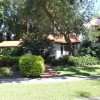 Urban landscapes in Florida are typically dominated by turfgrass monoculture, with ornamental landscape plants comprising only a small portion of the landscape. Incorporating more woody ornamentals into your landscape can reduce fertilization and irrigation demand and help reduce nutrient leaching losses from your yard—a combination that will help protect Florida’s water resources. This 3-page fact sheet was written by Drew C. McLean, Andrew K. Koeser, Amy L Shober, Zhixuan Qin, Gitta Hasing, and Richard C. Beeson, and published by the UF Department of Environmental Horticulture, July 2014.
Urban landscapes in Florida are typically dominated by turfgrass monoculture, with ornamental landscape plants comprising only a small portion of the landscape. Incorporating more woody ornamentals into your landscape can reduce fertilization and irrigation demand and help reduce nutrient leaching losses from your yard—a combination that will help protect Florida’s water resources. This 3-page fact sheet was written by Drew C. McLean, Andrew K. Koeser, Amy L Shober, Zhixuan Qin, Gitta Hasing, and Richard C. Beeson, and published by the UF Department of Environmental Horticulture, July 2014.
http://edis.ifas.ufl.edu/ep503
Smooth-bark Mexican Pine (Pinus pseudostrobus)
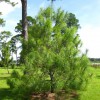 This beautiful pine is distinguished by long, pendulous needles that form a graceful, open evergreen conifer. The slender needles are up to 12 inches long in groups (fascicles) of five. In its native environment, smooth-bark Mexican pine is considered fast growing, and can reach more than 120 feet tall and about 60 feet wide. In southern Georgia, trees have reached heights of 32 feet and widths of 25 feet in 10 years. Trees have a pyramidal form when young, becoming flat-topped with age. In its native range, smooth-bark Mexican pine grows in temperate to warm temperate areas with predominately summer rainfall. Florida’s similar climatic conditions suggest that smooth-bark Mexican pine will adapt well throughout the state. Cold hardiness is not well-defined, but this species has grown well in southern Georgia (USDA Cold Hardiness Zone 8b). This 2-page fact sheet was written by Gary W. Knox, and published by the UF Department of Environmental Horticulture, June 2014.
This beautiful pine is distinguished by long, pendulous needles that form a graceful, open evergreen conifer. The slender needles are up to 12 inches long in groups (fascicles) of five. In its native environment, smooth-bark Mexican pine is considered fast growing, and can reach more than 120 feet tall and about 60 feet wide. In southern Georgia, trees have reached heights of 32 feet and widths of 25 feet in 10 years. Trees have a pyramidal form when young, becoming flat-topped with age. In its native range, smooth-bark Mexican pine grows in temperate to warm temperate areas with predominately summer rainfall. Florida’s similar climatic conditions suggest that smooth-bark Mexican pine will adapt well throughout the state. Cold hardiness is not well-defined, but this species has grown well in southern Georgia (USDA Cold Hardiness Zone 8b). This 2-page fact sheet was written by Gary W. Knox, and published by the UF Department of Environmental Horticulture, June 2014.
http://edis.ifas.ufl.edu/ep500